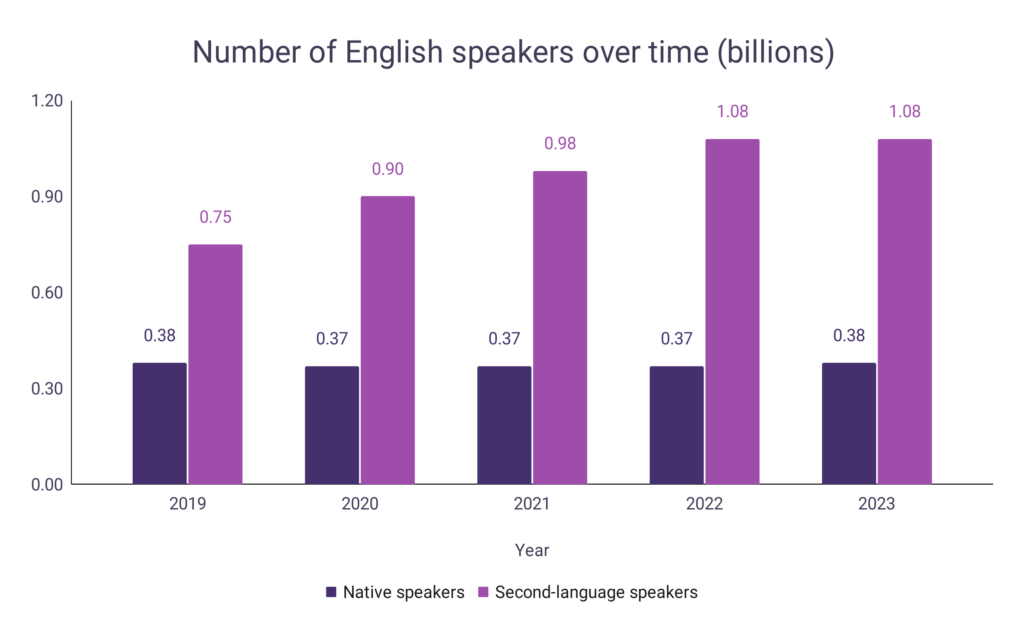Originating in England and now widely spoken across the globe, English has become the preferred language for learners due to the numerous opportunities it offers, among other reasons. In this WordsRated article, we explore the total number of English speakers, the countries where it is recognized as an official language, and the English Proficiency Index.
- As of 2023, approximately 1.46 billion people worldwide speak English, representing 18.07% of the global population—nearly 1 in 5 people.
- English surpasses all other languages in terms of the number of speakers, with about 28% more people speaking English than Mandarin Chinese, the second-most spoken language.
- Among English speakers, 26% use it as their first language, while 74% speak it as a second language.
- English is the most commonly taught foreign language globally. By 2050, the number of English speakers is projected to reach 2 billion.
- The term “Anglosphere” refers to regions with cultural ties to England, where English is widely spoken.
- The “Core Anglosphere” includes the United States, United Kingdom, Canada, Australia, and New Zealand, where English is the official language.
- Beyond its widespread use, English is also the primary language in professional fields such as science, navigation, and law.
- Those who speak English are often referred to as “Anglophones.”
Number of English speakers over time
English is the fastest-growing language in the world, with a large number of people prioritizing it as a foreign language because of its significant importance in professional settings.
- The total number of English speakers grew from 1.13 billion in 2019 to 1.46 billion in 2023, marking a 29.20% increase over this five-year period.
- As of 2023, the number of native English speakers remains steady at 0.38 billion, the same as in 2019.
- However, the number of second-language English speakers saw significant growth, rising from 0.75 billion in 2019 to 1.08 billion in 2023—a 44.00% increase over the period.
| Year | Native speakers | Second-language speakers | Total speakers | Total change |
| 2023 | 0.38 billion | 1.08 billion | 1.46 billion | + 0.69% |
| 2022 | 0.37 billion | 1.08 billion | 1.45 billion | + 7.41% |
| 2021 | 0.37 billion | 0.98 billion | 1.35 billion | + 6.30% |
| 2020 | 0.37 billion | 0.90 billion | 1.27 billion | + 12.39% |
| 2019 | 0.38 billion | 0.75 billion | 1.13 billion |
A graph is given below to show the number of English speakers over time:

Countries where English is an official language
English is recognized as an official language in 67 countries, where it serves as a predominant language, a de jure official language, or a de facto working language.
Predominant language
- Four countries list English as a predominant language, with a combined population of approximately 439 million people.
- The United States accounts for around 77% of this total, with a population of about 340 million.
- In these countries, English is spoken by:
- Approximately 265 million people in the United States (78% of the population).
- Around 66 million people in the United Kingdom (98% of the population).
- About 19 million people in Australia (72% of the population).
- Roughly 5 million people in New Zealand (95% of the population).
| # | Country | Population (2023) |
| 1 | United States | 339,996,563 |
| 2 | United Kingdom | 67,736,802 |
| 3 | Australia | 26,439,111 |
| 4 | New Zealand | 5,228,100 |
De jure official language
- English is designated as a de jure official language in 53 countries, with a combined population of 2.55 billion people.
- India alone accounts for around 56% of this total, with a population of approximately 1.43 billion. In these countries:
- India has approximately 143 million English speakers, representing about 10% of its population.
- In Nigeria, around 60% of the population speaks English, totaling over 134 million people.
- In Pakistan, around 50% of the population, or over 120 million people, can speak English.
| # | Country | Population (2023) |
| 1 | India | 1,428,627,663 |
| 2 | Pakistan | 240,485,658 |
| 3 | Nigeria | 223,804,632 |
| 4 | Philippines | 117,337,368 |
| 5 | Tanzania | 67,438,106 |
| 6 | South Africa | 60,414,495 |
| 7 | Kenya | 55,100,586 |
| 8 | Uganda | 48,582,334 |
| 9 | Sudan | 48,109,006 |
| 10 | Canada | 38,781,291 |
| 11 | Ghana | 34,121,985 |
| 12 | Cameroon | 28,647,293 |
| 13 | Malawi | 20,931,751 |
| 14 | Zambia | 20,569,737 |
| 15 | Zimbabwe | 16,665,409 |
| 16 | Rwanda | 14,094,683 |
| 17 | Burundi | 13,238,559 |
| 18 | South Sudan | 11,088,796 |
| 19 | Papua New Guinea | 10,329,931 |
| 20 | Sierra Leone | 8,791,092 |
| 21 | Singapore | 6,014,723 |
| 22 | Liberia | 5,418,377 |
| 23 | Ireland | 5,056,935 |
| 24 | Jamaica | 2,825,544 |
| 25 | The Gambia | 2,773,168 |
| 26 | Botswana | 2,675,352 |
| 27 | Namibia | 2,604,172 |
| 28 | Lesotho | 2,330,318 |
| 29 | Trinidad and Tobago | 1,534,937 |
| 30 | Eswatini | 1,210,822 |
| 31 | Fiji | 936,375 |
| 32 | Guyana | 813,834 |
| 33 | Solomon Islands | 740,424 |
| 34 | Micronesia | 544,321 |
| 35 | Malta | 535,064 |
| 36 | The Bahamas | 412,623 |
| 37 | Belize | 410,825 |
| 38 | Vanuatu | 334,506 |
| 39 | Barbados | 281,995 |
| 40 | Samoa | 225,681 |
| 41 | Saint Lucia | 180,251 |
| 42 | Kiribati | 133,515 |
| 43 | Grenada | 126,183 |
| 44 | Tonga | 107,773 |
| 45 | Seychelles | 107,660 |
| 46 | Saint Vincent and the Grenadines | 103,698 |
| 47 | Antigua and Barbuda | 94,298 |
| 48 | Dominica | 73,040 |
| 49 | Saint Kitts and Nevis | 47,755 |
| 50 | Marshall Islands | 41,996 |
| 51 | Palau | 18,058 |
| 52 | Nauru | 12,780 |
| 53 | Tuvalu | 11,396 |
De facto working language
- In 10 countries, English is used as a de facto working language, meaning it is used for official purposes but is not legally mandated.
- These countries have a combined population of around 254 million people.
- Bangladesh makes up approximately 68% of this total, with a population of around 173 million.
- In Bangladesh, an estimated 12% of the population, or about 21 million people, can speak English.
| # | Country | Population (2023) |
| 1 | Bangladesh | 172,954,319 |
| 2 | Malaysia | 34,308,525 |
| 3 | Sri Lanka | 21,893,579 |
| 4 | United Arab Emirates | 9,516,871 |
| 5 | Israel | 9,174,520 |
| 6 | Qatar | 2,716,391 |
| 7 | Timor-Leste | 1,360,596 |
| 8 | Mauritius | 1,300,557 |
| 9 | Bhutan | 787,424 |
| 10 | Brunei | 452,524 |
If you’re learning English and need a little help with word games, be sure to check out the WordsRated Word Finder to give your vocabulary a boost!
English proficiency index
The English Proficiency Index ranks countries based on their overall English language skills. To be included in the ranking, each country must have at least 400 adult test takers for their scores to be analyzed and compared.
As of 2023, the English Proficiency Index indicates that the Netherlands has the highest proficiency scores among the analyzed countries. Here’s a breakdown of proficiency levels by country:
- 12 countries (10.62%) achieved very high proficiency levels.
- 18 countries (15.93%) reached high proficiency levels.
- 33 countries (29.20%) attained moderate proficiency levels.
- 28 countries (24.78%) were at low proficiency levels.
- 22 countries (19.47%) scored very low proficiency levels.
When comparing average scores by continent:
- Europe leads with an average score of 570.
- Latin America follows with an average score of 508.
- Asia is in third place with an average score of 486.
- Africa ranks fourth with an average score of 469.
- The Middle East comes fifth with an average score of 455.
| # | Country | Region | Proficiency Level | Score |
| 1 | Netherlands | Europe | Very high proficiency | 647 |
| 2 | Singapore | Asia | Very high proficiency | 631 |
| 3 | Austria | Europe | Very high proficiency | 616 |
| 4 | Denmark | Europe | Very high proficiency | 615 |
| 5 | Norway | Europe | Very high proficiency | 614 |
| 6 | Sweden | Europe | Very high proficiency | 609 |
| 7 | Belgium | Europe | Very high proficiency | 608 |
| 8 | Portugal | Europe | Very high proficiency | 607 |
| 9 | South Africa | Africa | Very high proficiency | 605 |
| 10 | Germany | Europe | Very high proficiency | 604 |
| 11 | Croatia | Europe | Very high proficiency | 603 |
| 12 | Greece | Europe | Very high proficiency | 602 |
| 13 | Poland | Europe | High proficiency | 598 |
| 14 | Finland | Europe | High proficiency | 597 |
| 15 | Romania | Europe | High proficiency | 596 |
| 16 | Bulgaria | Europe | High proficiency | 589 |
| 17 | Hungary | Europe | High proficiency | 588 |
| 18 | Slovakia | Europe | High proficiency | 587 |
| 19 | Kenya | Africa | High proficiency | 584 |
| 20 | Philippines | Asia | High proficiency | 578 |
| 21 | Lithuania | Europe | High proficiency | 576 |
| 22 | Luxembourg | Europe | High proficiency | 575 |
| 23 | Estonia | Europe | High proficiency | 570 |
| 24 | Serbia | Europe | High proficiency | 569 |
| 25 | Malaysia | Asia | High proficiency | 568 |
| 26 | Czech Republic | Europe | High proficiency | 565 |
| 27 | Nigeria | Africa | High proficiency | 562 |
| 28 | Argentina | Latin America | High proficiency | 560 |
| 29 | Hong Kong | Asia | High proficiency | 558 |
| 30 | Switzerland | Europe | High proficiency | 553 |
| 31 | Honduras | Latin America | Moderate proficiency | 544 |
| 32 | Georgia | Europe | Moderate proficiency | 541 |
| 33 | Belarus | Europe | Moderate proficiency | 539 |
| 34 | Ghana | Africa | Moderate proficiency | 537 |
| 35 | Spain | Europe | Moderate proficiency | 535 |
| Italy | Europe | Moderate proficiency | 535 | |
| Moldova | Europe | Moderate proficiency | 535 | |
| 38 | Costa Rica | Latin America | Moderate proficiency | 534 |
| 39 | Albania | Europe | Moderate proficiency | 533 |
| Uruguay | Latin America | Moderate proficiency | 533 | |
| 41 | Bolivia | Latin America | Moderate proficiency | 532 |
| Russia | Europe | Moderate proficiency | 532 | |
| 43 | Cuba | Latin America | Moderate proficiency | 531 |
| France | Europe | Moderate proficiency | 531 | |
| 45 | Ukraine | Europe | Moderate proficiency | 530 |
| Paraguay | Latin America | Moderate proficiency | 530 | |
| 47 | Uganda | Africa | Moderate proficiency | 529 |
| 48 | Armenia | Europe | Moderate proficiency | 528 |
| 49 | South Korea | Asia | Moderate proficiency | 525 |
| 50 | El Salvador | Latin America | Moderate proficiency | 524 |
| 51 | Peru | Latin America | Moderate proficiency | 521 |
| 52 | Chile | Latin America | Moderate proficiency | 518 |
| 53 | Guatemala | Latin America | Moderate proficiency | 515 |
| 54 | Israel | Middle East | Moderate proficiency | 514 |
| 55 | Dominican Republic | Latin America | Moderate proficiency | 512 |
| 56 | Venezuela | Latin America | Moderate proficiency | 508 |
| 57 | Nepal | Asia | Moderate proficiency | 507 |
| 58 | Iran | Middle East | Moderate proficiency | 505 |
| Vietnam | Asia | Moderate proficiency | 505 | |
| 60 | Bangladesh | Asia | Moderate proficiency | 504 |
| India | Asia | Moderate proficiency | 504 | |
| 62 | Nicaragua | Latin America | Moderate proficiency | 503 |
| 63 | Tunisia | Africa | Moderate proficiency | 502 |
| 64 | Pakistan | Asia | Low proficiency | 497 |
| 65 | Lebanon | Middle East | Low proficiency | 496 |
| 66 | Turkey | Europe | Low proficiency | 493 |
| 67 | Sri Lanka | Asia | Low proficiency | 491 |
| Tanzania | Africa | Low proficiency | 491 | |
| 69 | Ethiopia | Africa | Low proficiency | 490 |
| 70 | Brazil | Latin America | Low proficiency | 487 |
| 71 | United Arab Emirates | Middle East | Low proficiency | 486 |
| Panama | Latin America | Low proficiency | 486 | |
| 73 | Mongolia | Asia | Low proficiency | 482 |
| Qatar | Middle East | Low proficiency | 482 | |
| 75 | Colombia | Latin America | Low proficiency | 480 |
| 76 | Morocco | Africa | Low proficiency | 478 |
| 77 | Algeria | Africa | Low proficiency | 475 |
| 78 | Madagascar | Africa | Low proficiency | 474 |
| 79 | Indonesia | Asia | Low proficiency | 473 |
| 80 | Ecuador | Latin America | Low proficiency | 467 |
| Syria | Middle East | Low proficiency | 467 | |
| 82 | China | Asia | Low proficiency | 464 |
| 83 | Azerbaijan | Europe | Low proficiency | 463 |
| Egypt | Africa | Low proficiency | 463 | |
| 85 | Kuwait | Middle East | Low proficiency | 461 |
| 86 | Malawi | Africa | Low proficiency | 460 |
| 87 | Japan | Asia | Low proficiency | 457 |
| 88 | Afghanistan | Asia | Low proficiency | 456 |
| 89 | Mexico | Latin America | Low proficiency | 451 |
| 90 | Myanmar | Asia | Low proficiency | 450 |
| Kyrgyzstan | Asia | Low proficiency | 450 | |
| 92 | Palestine | Middle East | Very low proficiency | 445 |
| 93 | Uzbekistan | Asia | Very low proficiency | 442 |
| 94 | Cameroon | Africa | Very low proficiency | 438 |
| Senegal | Africa | Very low proficiency | 438 | |
| 96 | Jordan | Middle East | Very low proficiency | 431 |
| 97 | Sudan | Africa | Very low proficiency | 430 |
| 98 | Cambodia | Asia | Very low proficiency | 421 |
| Haiti | Latin America | Very low proficiency | 421 | |
| 100 | Oman | Middle East | Very low proficiency | 418 |
| 101 | Angola | Africa | Very low proficiency | 416 |
| Thailand | Asia | Very low proficiency | 416 | |
| Benin | Africa | Very low proficiency | 416 | |
| 104 | Kazakhstan | Asia | Very low proficiency | 415 |
| 105 | Somalia | Africa | Very low proficiency | 411 |
| 106 | Iraq | Middle East | Very low proficiency | 410 |
| 107 | Côte d’Ivoire | Africa | Very low proficiency | 409 |
| 108 | Saudi Arabia | Middle East | Very low proficiency | 408 |
| 109 | Rwanda | Africa | Very low proficiency | 405 |
| 110 | Libya | Africa | Very low proficiency | 392 |
| Yemen | Middle East | Very low proficiency | 392 | |
| 112 | Tajikistan | Asia | Very low proficiency | 388 |
| 113 | DR Congo | Africa | Very low proficiency | 385 |
FAQ’s
How many people speak English worldwide?
- As of 2023, approximately 1.46 billion people speak English globally.
What percentage of the world’s population speaks English?
- English is spoken by about 18.07% of the global population.
How does the number of English speakers compare to other languages?
- English has more speakers than any other language, including Mandarin Chinese, the second-most spoken language.
How many of the English speakers are native speakers?
- There are around 0.38 billion (380 million) native English speakers.
How many people speak English as a second language?
- Approximately 1.08 billion people speak English as a second language.
What is the projected number of English speakers by 2050?
- The number of English speakers is expected to reach 2 billion by 2050.
In how many countries is English an official language?
- English is listed as an official language in 67 countries.
How many countries have English as a predominant language?
- English is a predominant language in 4 countries.
What is the total population of countries where English is a predominant language?
- The total population of these countries is approximately 439 million.
Which country has the largest number of English speakers among the predominant English-speaking countries?
- The United States has the largest number, with about 265 million English speakers.
How many English speakers are there in the United Kingdom?
- Approximately 66 million people speak English in the United Kingdom.
How many people speak English in Australia?
- Around 19 million people speak English in Australia.
How many English speakers are there in New Zealand?
- About 5 million people speak English in New Zealand.
How many countries list English as a de jure official language?
- English is listed as a de jure official language in 53 countries.
What is the total population of countries where English is a de jure official language?
- The total population of these countries is 2.55 billion people.
How many English speakers are there in India?
- India has around 143 million English speakers.
What percentage of India’s population speaks English?
- About 10% of India’s population speaks English.
How many English speakers are there in Nigeria?
- Nigeria has over 134 million English speakers.
What percentage of Pakistan’s population can speak English?
- Approximately 50% of Pakistan’s population can speak English, amounting to over 120 million people.
How many countries use English as a de facto working language?
- English is used as a de facto working language in 10 countries.











![Science Fiction Book Sales Statistics [2023]](https://wordiplypro.com/wp-content/uploads/2024/09/Add-a-heading-17-300x169.jpg)



